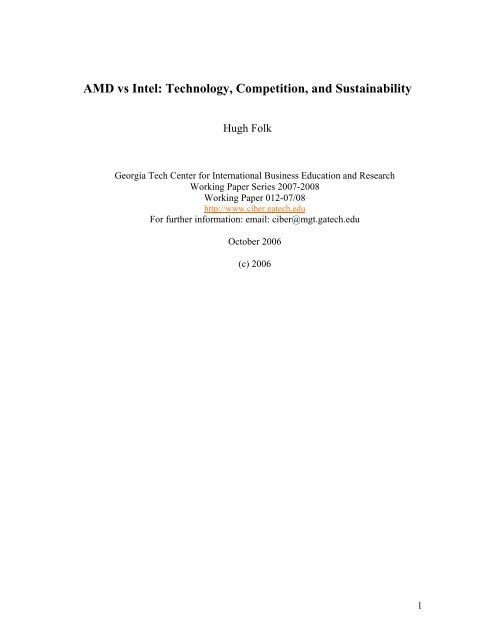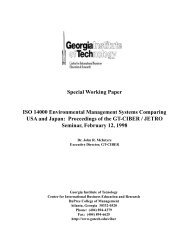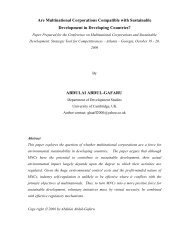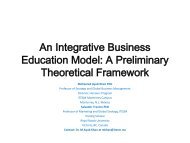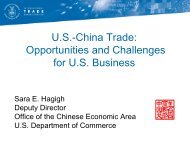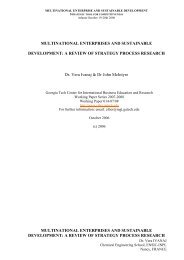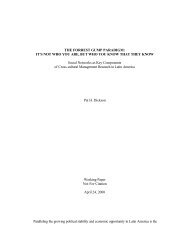AMD vs Intel: Technology, Competition, and Sustainability
AMD vs Intel: Technology, Competition, and Sustainability
AMD vs Intel: Technology, Competition, and Sustainability
Create successful ePaper yourself
Turn your PDF publications into a flip-book with our unique Google optimized e-Paper software.
<strong>AMD</strong> <strong>vs</strong> <strong>Intel</strong>: <strong>Technology</strong>, <strong>Competition</strong>, <strong>and</strong> <strong>Sustainability</strong><br />
Hugh Folk<br />
Georgia Tech Center for International Business Education <strong>and</strong> Research<br />
Working Paper Series 2007-2008<br />
Working Paper 012-07/08<br />
http://www.ciber.gatech.edu<br />
For further information: email: ciber@mgt.gatech.edu<br />
October 2006<br />
(c) 2006<br />
1
<strong>AMD</strong> <strong>vs</strong> <strong>Intel</strong>: <strong>Technology</strong>, <strong>Competition</strong>, <strong>and</strong> <strong>Sustainability</strong><br />
Hugh Folk 1<br />
<strong>Technology</strong><br />
Computers will influence everything that is do in the future. Now they store,<br />
process, <strong>and</strong> communicate all of the information of politics, business, education,<br />
medicine, literature, music, telephone calls, science, <strong>and</strong> technology. They are our<br />
companions <strong>and</strong> our teachers. They are our untiring associates in research, invention, <strong>and</strong><br />
discovery. Just to prove that they are only human, they sometimes err.<br />
Computers are largely composed of microprocessors <strong>and</strong> memory chips which are<br />
integrated circuits containing millions, sometimes billions of transistors <strong>and</strong> are made<br />
largely of silicon, one of the most plentiful atoms in the earth’s crust. The complexity or<br />
number of transistors of the average integrated circuit increases by about 58 percent a<br />
year. Average productivity (output per man hour) in the semiconductor industry<br />
increases by about 27 percent a year. Microprocessors are the part of the computer that<br />
performs the mathematical <strong>and</strong> logical operations referred to as computing. The speed<br />
<strong>and</strong> power of a particular state-of-the-art microprocessor design (an <strong>AMD</strong> Athlon or an<br />
<strong>Intel</strong> Core 2 Duo) depend on the architecture, or design, of the number <strong>and</strong> size of the<br />
billions of transistors to be incorporated into each of the several hundred identical dies, or<br />
slivers of processed silicon, on the thin, round 300 mm wafer of silicon <strong>and</strong> the<br />
conductivity of the lines, or narrow, flat, thin copper wires that will interconnect the<br />
transistors. Each design is put together by experts using specialized computer programs<br />
which combine new or previously used modules to make the patterns for masks through<br />
which extreme lasers project high frequency 248 or 193 nm ultraviolet light which forms<br />
tiny interference patterns on the processed silicon wafers which solubilize the<br />
photoresistant compound previously spun on the wafer. A hundred or more similar steps,<br />
each requiring specialized equipment <strong>and</strong> reagents arranged in separate work stations to<br />
etch channels, deposit metal interconnects <strong>and</strong> silicon dioxide insulating layers, or<br />
connect the several layers that make up the chip. Each work station will have automated<br />
wafer manipulation equipment to remove each partially processed wafer from a multiwafer<br />
carrier or cassette, <strong>and</strong> insert each wafer into a dust free vacuum reaction chamber<br />
where it is processed. Each reaction chamber utilizes a unique, corrosive, toxic chemical<br />
or high-termperature vaporized metal generated on site or pipelined through the dust-free<br />
“clean room” where the processing stations are located. At any step, a single grain of dust<br />
can destroy a die that if completed would sell for several hundred dollars. 2<br />
1 Professor of Management, Shidler College of Business, University of Hawaii at Manoa, folk@hawaii.edu.<br />
2 Fab cost accounting is very strange. Yield, or average percentage of good chips from a wafer, is said to be<br />
critical to economic success, but the market price of the chip itself if only a few dollars per square<br />
centimeter of silicon. That is to say, variables costs are quite low. The fixed cost of the completed design<br />
<strong>and</strong> the fixed cost (in the billions) of an up-to-date fab <strong>and</strong> the 60 percent gross margin set the multihundred<br />
dollar price of the microprocessor chip. Design <strong>and</strong> fab costs are sunk <strong>and</strong> must be recovered for<br />
2
No industry has grown as rapidly over the past 40 years as the semiconductor<br />
industry In 2005, $229 billion dollars worth of semiconductors were sold.<br />
Microprocessors are the most important semiconductor product, <strong>and</strong> most<br />
microprocessors are x86 chips with an augmented instruction set which is backwardly<br />
compatible with the software written for the 8088 chips used in the original IBM PC/XT<br />
of 1981. IBM selected the 8088 chip designed by <strong>Intel</strong> <strong>and</strong> required <strong>Intel</strong> to license a<br />
number of second sources. IBM also selected the Microsoft MS/DOS as the nonexclusive<br />
operating system <strong>and</strong> paid a lump sum for unlimited copies. 3 Microsoft<br />
retained the right to sell MS/DOS to companies that wanted to clone the PC, thereby<br />
creating the IBM compatible market. The x86 architecture has flourished. Most<br />
Microprocessors in PC’s are x86 architecture. As are more than half of microprocessors<br />
qreAt all levels, PC, server, <strong>and</strong> supercomputer, microprocessors do most of the<br />
computing.Most x86 microprocessors today are manufactured by <strong>Intel</strong> (80 percent) <strong>and</strong><br />
Advanced Micro Devices (<strong>AMD</strong>) (20 percent). There other firms, such as IBM <strong>and</strong><br />
Transmeta have produced x86’s but do so no longer.<br />
Starting in 1983, <strong>Intel</strong> designed <strong>and</strong> introduced new generations of faster x86<br />
chips every four <strong>and</strong> then every two years. OEM clone customers for the most part were<br />
apathetic about speed increases. <strong>Intel</strong> announced the more powerful 80286, which IBM<br />
used in its much faster PC/AT. Beset with Japanese competition <strong>and</strong> dumping, <strong>Intel</strong><br />
(which thought of itself as “The Memory Compny”) ab<strong>and</strong>oned the production of<br />
memory chips <strong>and</strong> became “The Microprocessor Company.” It aimed all of its efforts on<br />
improving <strong>and</strong> marketing microprocessors <strong>and</strong> the PC itself. <strong>Intel</strong> had been unable to<br />
monopolize the 8088. Its market share was about 30 percent for the 8088 in 1984, <strong>and</strong> 65<br />
percent for the 80286 chips (introduced in 1983). However, Andrew Grove, the CEO,<br />
decided to increase its return on intellectual property <strong>and</strong> monopolize the chips <strong>Intel</strong><br />
designed. This was thought to be a perfectly legal, since a nonexistent product could<br />
hardly be said to constitute “a market.” <strong>Intel</strong> invested $100 million in designing <strong>and</strong> $200<br />
in producing the i386 at a time when it had laid off workers in memory (1985) <strong>and</strong> was<br />
about to book big losses in the next year. However, <strong>Intel</strong> had licensed <strong>AMD</strong> <strong>and</strong> others<br />
to produce the 8088 <strong>and</strong> 80286. <strong>AMD</strong> assumed that it had a license to copy the 386<br />
microinstructions, but <strong>Intel</strong> obtained an injunction barring <strong>AMD</strong> from using the <strong>Intel</strong><br />
microinstructions. <strong>AMD</strong> used “clean-room” techniques that did not violate the injunction<br />
or use <strong>Intel</strong> technology to produce the AM 386/40 in 1991. <strong>AMD</strong> countersued <strong>Intel</strong><br />
claiming its license included the 386 microinstructions <strong>and</strong> was awarded damages. In<br />
1995 the legal dispute was settled. <strong>AMD</strong> was paid compensation. <strong>Intel</strong> granted a new<br />
license including everything x86 as far as the 386 technology but no further. <strong>Intel</strong> had<br />
sold several billion dollars worth of 386’s, <strong>and</strong> had excluded competition for six years, at<br />
the cost of several hundred million in legal fees <strong>and</strong> compensation to <strong>AMD</strong>. It had<br />
successfully monopolized the 386 <strong>and</strong> had been able to spend $500 million in developing<br />
its successor i486 (1989) which it introduced at $1,500. <strong>Intel</strong> was able to exp<strong>and</strong><br />
overseas <strong>and</strong> build fabs in Irel<strong>and</strong> <strong>and</strong> Israel for additional capacity in advance of<br />
profitability. The chips must be produced <strong>and</strong> sold as long as the price covers variable cost <strong>and</strong> does not<br />
cannibalize other products.<br />
3 IBM obtained a license, which it used later to develop OS/2 jointly with Microsoft, <strong>and</strong> then alone.<br />
3
dem<strong>and</strong>. 4 If either duopolist developed a more powerful or cheaper chip <strong>and</strong> increased<br />
dem<strong>and</strong>, the one with greater unused capacity would be able to supply the dem<strong>and</strong>, while<br />
the one without excess capacity could not.<br />
IBM delayed adopting the i386 for a year, <strong>and</strong> Compaq became the biggest PC<br />
seller. <strong>Intel</strong>’s slogan of “<strong>Intel</strong> Inside” led users to identify the microprocessor as the key<br />
part of the PC. What mattered was the br<strong>and</strong> of chip not the br<strong>and</strong> of the box. As 386<br />
competition arose, <strong>Intel</strong> started paying half of its OEM <strong>and</strong> merchant advertising costs for<br />
<strong>Intel</strong>-equipped products. Big computer retailers <strong>and</strong> br<strong>and</strong>s would feature their <strong>Intel</strong><br />
products (for which they got rebates <strong>and</strong> ignore <strong>AMD</strong>. <strong>AMD</strong> never seemed to pay<br />
rebates. There were no old x86’s PC’s that could compare with those using the i386. The<br />
part had come to dominate the whole. The clone makers did nothing to improve the PC,<br />
<strong>and</strong> <strong>Intel</strong> took increasing control of the computer’s interior, introducing the PCI bus<br />
which increased overall speed by four or five times, <strong>and</strong> permitted the new, faster chips<br />
to perform up to capacity. <strong>Intel</strong> began markerting chip sets <strong>and</strong> mother boards, increasing<br />
its share of value added.<br />
The faster i486 (1989) dominated the PC industry until 1993, even though other<br />
companies later introduced 486s.<br />
In 1993, <strong>Intel</strong> introduced the faster technologically-advanced Pentium. A math<br />
professor discovered <strong>and</strong> explained an error in the floating point unit, <strong>and</strong> disclosed it an<br />
Internet newsgroup whence it rapidly spread to the headlines. <strong>Intel</strong> had discovered the<br />
same defect earlier, <strong>and</strong> had decided that it was not bad enough to recall the defective<br />
parts -- an astonishing blunder. The defects were repaired in future steppings of the chip,<br />
but when the “floating point error” became public there was a storm of criticism. IBM<br />
stopped selling Pentiums for the time being. Memories are long, <strong>and</strong> <strong>Intel</strong> haters keep up<br />
complaints to this day. <strong>Intel</strong> finally got it offered replacements, first to serious math<br />
users, <strong>and</strong> later to every purchaser. <strong>Intel</strong> took a $475 million charge to cover the recall,<br />
<strong>and</strong> lost much prestige but had the best year in its history. There was no rival to the<br />
Pentium until <strong>AMD</strong>’s answered in 1005 with the <strong>AMD</strong> 586 K5.which some brilliant<br />
design ideas but was poorly executed. Meanwhile, <strong>Intel</strong> developed the P-6 or Pentium<br />
Pro. <strong>AMD</strong> acquired NexGen, (started by former <strong>Intel</strong> engineers who had helped design<br />
the Pentium). The NexGen team developed the <strong>AMD</strong> K6. It was successful technically<br />
<strong>and</strong> commercially. It saved <strong>AMD</strong>. It was superior technically to the Pentium <strong>and</strong> cheaper<br />
than <strong>Intel</strong> Pentium II. Capacity limited, <strong>AMD</strong> contracted to build <strong>and</strong> operate Fab 30 in<br />
Dresden as part of an integrated semiconductor initiative in former East Germany. It<br />
joined all the right clubs <strong>and</strong> begged large subsidies as befitting a German Company. The<br />
next years were filled with vigorous competition. <strong>Intel</strong> introduced the successful Pentium<br />
II, based on the P6 architecture in 19977, Both the PII <strong>and</strong> <strong>AMD</strong>’s K6 went through<br />
speed upgrades, as the transistor <strong>and</strong> line width were reduced, <strong>and</strong> production moved<br />
from 150 mm wafers to 200 mm wafers in the new fabs that both companies built. <strong>AMD</strong><br />
usually lagged a year or so in the new technologies, but its chips drew closer to <strong>Intel</strong> in<br />
speed <strong>and</strong> performance. The Pentium III, introduced in 1999 <strong>and</strong> went through speed<br />
upgrades but suffered from the dot.com collapse in 2001 which set IT spending back. The<br />
Pentium III fell behind the <strong>AMD</strong> Athlon speed in 2001 <strong>and</strong> <strong>AMD</strong> seized the virtual Blue<br />
4 A well-known monopolistic practice pioneered by Alcoa.<br />
4
Ribbon for the fastest x86 chip. <strong>Intel</strong> started an intense sales effort to win back OEMs<br />
prompted the <strong>AMD</strong> antitrust suit in 2005. The <strong>Intel</strong> design team had extended the life of<br />
the P6 architecture about as far as it could go¸ <strong>and</strong> other team introduced the P4<br />
“NetBurst” architecture which developed slowly developed <strong>and</strong> never got over 3.8 GHz.<br />
Serious mistakes had been made in designing the 64-bit extensions for the Itanium <strong>and</strong> P4<br />
which made legacy 32 code so slow that <strong>Intel</strong> lost benchmark comparisons to the <strong>AMD</strong><br />
Athlon 64 (1991) <strong>and</strong> Opteron (1903). The Opteron enjoy wide acceptance in servers,<br />
<strong>and</strong> <strong>AMD</strong> became a serious continder, its market share in x86 servers went from nothing<br />
to 25 percent. <strong>Intel</strong> also had problems with waste heat. The power used by the P4 was<br />
higher than the Athlon, <strong>and</strong> this became an important issue. <strong>Intel</strong> had been able to<br />
dominate the x86 microprocessor industry in power <strong>and</strong> speed <strong>and</strong> charge price premiums<br />
for fifteen years, <strong>and</strong> now (2003) things looked as if they were goiog to hell. <strong>Intel</strong><br />
introduced the Pentium D with two cores on separate chips in the same package, but<br />
<strong>AMD</strong> double core chips continued to outperform. Sales increased <strong>and</strong> profits turned<br />
positive.<br />
In July of 2006, <strong>Intel</strong> introduced three Core 2 chips, each with two cores for PC’s,<br />
laptops, <strong>and</strong> servers.. <strong>Intel</strong> claimed that performance was improved 40 per cent, <strong>and</strong> heat<br />
dissipation was reduced by 40 percent. <strong>AMD</strong> claimed that their chips were superior <strong>and</strong><br />
that <strong>Intel</strong> was cheating on supposedly neutral benchmarks, <strong>and</strong> challenged <strong>Intel</strong> to a<br />
public contest using a third-party compiler. Apple ported OS X to the Core 2 <strong>and</strong><br />
announced its conversion to the church of <strong>Intel</strong>. <strong>Intel</strong> promiseded the Core 2 Quad for<br />
November.<br />
<strong>Competition</strong> <strong>and</strong> Antitrust<br />
Before 1985, <strong>AMD</strong> had only a minority share of the x86 market but <strong>Intel</strong> was not<br />
close to a monopoly. Grove began what turned out to be a long legal struggle with <strong>AMD</strong>.<br />
<strong>Intel</strong> i386/16 was introduced in 1985 at $299 <strong>and</strong> in 1990 cost $171. <strong>AMD</strong>’s 386DX/40<br />
appeared in 1991 at $281 <strong>and</strong> fell a year later to $140. <strong>AMD</strong> stock has performed<br />
irregularly for much of its life (Figure 1) peaking at 45 in 2000, then falling to 3 <strong>and</strong><br />
recovering to 42 in 2006, <strong>and</strong> then dropping to 24. INTC grew rapidly with few<br />
interruptions until the dot.com crash in 2000, when it fell from 72 to 5, <strong>and</strong> then<br />
fluctuated with a downtrend <strong>and</strong> recovered until 2005, before dropping in 2006. <strong>Intel</strong>’s<br />
stock fell after the 2000 peak <strong>and</strong> never recovered. <strong>AMD</strong>’s stock trended downward after<br />
2000, recovered after 2003, <strong>and</strong> then dropped sharply in 2006. Despite recovery in<br />
profits, the stock price dwindled deflecting doubts about the profitability of the industry<br />
<strong>and</strong> <strong>AMD</strong> itself.. <strong>AMD</strong> had large tax losses carried forward which made its after-tax<br />
profits negative until 2000, when its net income was $1 billion, becoming negative from<br />
2001 to 2003, before turning positive in 2004 <strong>and</strong> 2005.<br />
In July of 2005, with great fanfare, <strong>AMD</strong> filed a federal antitrust suit in Delaware<br />
(where <strong>Intel</strong> was incorporated) against <strong>Intel</strong> accusing it of abusing its monopoly by<br />
threatening to retaliate against customers who violated illegal exclusive dealing<br />
agreements by using or selling <strong>AMD</strong> products <strong>and</strong> by using payments <strong>and</strong> discounts to<br />
5
induce manufacturers <strong>and</strong> dealers to carry or prefer <strong>Intel</strong> chips. <strong>AMD</strong> CEO Hektor Ruiz,<br />
ordinarily a calm <strong>and</strong> reserved man, publicly denounced <strong>Intel</strong> as unfair <strong>and</strong> abusive. <strong>Intel</strong><br />
CEO Paul Otellini ridiculed <strong>AMD</strong>’s performance, claiming that its recent successes<br />
showed that when <strong>AMD</strong> had good parts it could sell them but it was incapable of<br />
producing enough good chips to meet dem<strong>and</strong> when they did have winners. In its answer,<br />
<strong>Intel</strong> denied any illegal acts <strong>and</strong> moved for dismissal. A year later, the judge dismissed<br />
those counts that accused <strong>Intel</strong> of illegal acts in Europe <strong>and</strong> Japan for lack of jurisdiction.<br />
<strong>AMD</strong> had filed antitrust suits in those places. <strong>AMD</strong> had previously sued <strong>Intel</strong> dem<strong>and</strong>ing<br />
discovery of documents to help them in its planned European suit. <strong>Intel</strong> lost in the U.S.<br />
Supreme Court in 2004, <strong>and</strong> <strong>AMD</strong> won the right of discovery of antitrust violations by<br />
<strong>Intel</strong>. 5<br />
Antitrust law is one of America’s most bizarre <strong>and</strong> self-destructive gifts to the<br />
world. Justice Abe Fortas said that antitrust law was in the tradition of the old American<br />
west. Every once in a while, a frontier sheriff would pistol whip a citizen at r<strong>and</strong>om pour<br />
encourager les autres. He failed to add that the sheriff would then sometimes h<strong>and</strong> the<br />
pistol to the European commissioner of competition <strong>and</strong> let her continue to beat <strong>and</strong> rob<br />
the American citizen. It is a powerful tool with which a foreign government can harass<br />
great American exporters like Microsoft <strong>and</strong> <strong>Intel</strong>. The DOJ or FTC get the goods on an<br />
American firm <strong>and</strong> then had over the results of discovery to the foreign agencies. The<br />
coordinated international antitrust cooperative (or conspiracy) is aimed at American firms<br />
that give good deals <strong>and</strong> free goods to foreigners. The U.S. DOJ claims jurisdiction over<br />
foreigners’ antitrust violations only when American trade is impacted. The Eureopean<br />
commssioner claims jurisdiction over American firms whenever it wishes. She seems to<br />
have an insatiable desire to redesign American soft-ware packages <strong>and</strong> steal trade-secret<br />
code to enrich her co-conspirators who would like to sell something separately that<br />
Microsoft gives away as part of Windows. <strong>Intel</strong> is able to make a better deal for German<br />
companies than <strong>AMD</strong> can even though Gernany has granted it huge subsidies. Penalizing<br />
<strong>Intel</strong> for its mercantile acumen <strong>and</strong> economic strength is protectionism <strong>and</strong> illegal<br />
discrimination (violating WTO rules). The current Republican U.S. Administration has<br />
violated trade law so regularly in protecting decrepit American industries that it has little<br />
ability to or interest in protecting American high-tech exporters. As a rule, foreign firms<br />
have not been able to compute with American IT firms, so government regulators have<br />
been called in to rescue them. <strong>AMD</strong>, has outsourced all of its microprocessor<br />
manufacture to its highly subsidized Germany subsidiaries yet the U.S. IRS has allowed<br />
prior tax loss carryforwards to reduce its current U.S. tax obligations even though the<br />
losses were in large part caused by its mismanagement of its German <strong>and</strong> other foreign<br />
operations. <strong>AMD</strong> spent only $1 million for U.S. lobbying in 2005, far too little to justify<br />
the favors this Administration has given them.<br />
In the 1990’s the FTC investigated <strong>Intel</strong> for several years but imposed no<br />
penalties. <strong>Intel</strong> signed a consent decree that it would not withhold technical data required<br />
by its OEMs to design products for six months before the announced date for release of<br />
the <strong>Intel</strong> product. Nothing was said about the complaints that Compaq, DEC, <strong>and</strong><br />
Intergraph had made that <strong>Intel</strong> was retaliating against them for filing patent infringement<br />
5 <strong>Intel</strong> <strong>vs</strong> <strong>AMD</strong>. U.S. Reports. (2004)<br />
6
suits. It was widely suspected that <strong>Intel</strong>’s withholding of product specifications was a<br />
way of extorting a cheap license from a patentee. Even were <strong>Intel</strong> a monopolist, it would<br />
seem to be perfectly legal for one monopolist to exchange legitimate trade secrets for a<br />
legitimate patent license from another monopolist. In 2005, Japan Fair Trade<br />
Commission, acting on a complaint from <strong>AMD</strong>, recommended that <strong>Intel</strong> not continue<br />
rebate <strong>and</strong> incentive payments to OEMs.Bizarre behavior indeed for a country where<br />
many business deals have side payments, secret clauses, <strong>and</strong> political payoffs. <strong>Intel</strong> is still<br />
the beneficiary of the 20 percent U.S. share of the Japanese semiconductor agreement.<br />
<strong>AMD</strong> should not be, since with the sales of its flash facilities it no longer manufactures<br />
semiconductors in the United States on its own account. Korea’s antitrust agency raided<br />
<strong>Intel</strong>’s offices. In each of these cases, the suit was stirred up by complaints from <strong>AMD</strong>.<br />
The antitrust agencies in the U.S. have no way of getting information without cause to<br />
believe that the law has been broken. 6 DOJ <strong>and</strong> FTC have, so far, failed to charge <strong>Intel</strong><br />
with monopolization or unfair trade, <strong>and</strong> the court has dismissed the foreign counts for<br />
lack of jurisdiction.<br />
Armed with subpoena powers, <strong>AMD</strong> will try to prove a prima facie case of abuse<br />
of monopoly, but first it must prove <strong>Intel</strong> is a monopoly. If <strong>AMD</strong> should win, it will have<br />
to prove damages. But <strong>AMD</strong> was doing quite well by past st<strong>and</strong>ards until it started the<br />
price war. The trial is not schedule to start until 2009. It is quite possible that by the time<br />
the trial ends, <strong>AMD</strong> will be out of money. It will be if the price war continues.<br />
<strong>Intel</strong> CEO Otellini has publicly claimed that the <strong>AMD</strong> suit is primarily defensive,<br />
to prevent <strong>Intel</strong> from starting a price war. But <strong>AMD</strong> has already started the price war.<br />
<strong>Intel</strong> has cut Core 2 prices across the board, <strong>and</strong> <strong>AMD</strong> has cut back, always seeking a<br />
lower price performance curve than <strong>Intel</strong> has. As a result, 2006 has been a lousy year for<br />
both <strong>Intel</strong> <strong>and</strong> <strong>AMD</strong>: sales, profits, <strong>and</strong> stock prices have all fallen. In the past, <strong>Intel</strong><br />
would have maintained a substantial differential price over <strong>AMD</strong>, based on a claimed<br />
superiority of performance. <strong>Intel</strong> be able to show necessity when it cut prices. Not even a<br />
monopolist is required sell a superior product at a higher price than a competitor charges<br />
for an inferior product unless it is trying to destroy a competitor.<br />
The “rule of reason” applies to most acts. Behavior that a judge finds reasonable<br />
under the circumstances is legal. What is reasonable for a small struggling competitor<br />
like <strong>AMD</strong> need not be reasonable for a dominant firm like <strong>Intel</strong>.<br />
History indicates that few startups last very long, <strong>and</strong> few large firms remain large<br />
for very long. No dominant firm remains dominant for long. High tech firms fade after a<br />
few years when the firm is not able to produce successful follow-up products to the<br />
original innovative product. Dominant firms may innovate <strong>and</strong> invest in additional<br />
capacity at home <strong>and</strong> overseas in an attempt to preempt competition. It may merge with<br />
or acquire dominance in related industries. IBM dominated large business computers in<br />
1980 <strong>and</strong> had been sued by DOJ for monopoly, but it entered the PC industry that already<br />
had many small firms in it. If it had made any serious effort to exclude other firms from<br />
6 On two occasions in which I made specific inquiries of the FTC about a publicly disclosed per se<br />
violation, I was told to find on my own account sworn affidavits from participants or victims. I was told<br />
informally that FTC had not funds to institute investigations (using civil investigative dem<strong>and</strong>s) of r<strong>and</strong>om<br />
offenses on its own.<br />
7
the PC industry, someone would have sued <strong>and</strong> won. It rose to dominate PC sales but did<br />
not control the industry. <strong>Intel</strong> designed the 8086, but only grew to dominate the x86<br />
compatible industry by moving up-market, <strong>and</strong> cutting prices on the newer more<br />
powerful chips. <strong>AMD</strong> struggled to compete, even though it lost money many years. It<br />
carried out its own R&D program <strong>and</strong> acquired outside firms <strong>and</strong> got substantial<br />
subsidies from Germany <strong>and</strong> Saxony to build Fab 30 in Dresden. It survived, <strong>and</strong> now<br />
has some superior products. It continues to get huge subsidies from Germany. It can sell<br />
more chips than it can make. so it contracts foundry products from IBM <strong>and</strong> Chartered.<br />
<strong>AMD</strong> enjoyed a rise in stock prices from 2003 to 2006 (although though it has since<br />
fallen) while <strong>Intel</strong>’s stock price has trended down since 2001.<br />
The antitrust suits may have helped preserve competition in mainframe computers<br />
for a while, but could not preserve the industry itself. Antirust <strong>and</strong> patent suits against<br />
<strong>Intel</strong>, may have helped preserve competition in the minicomputer industry, but could not<br />
preserve the minicomputer industry. <strong>AMD</strong>’s antitrust suit against <strong>Intel</strong> may preserve a<br />
competitor, but it is only German subsidies that keep <strong>AMD</strong> alive. Without the German<br />
subsidies, <strong>AMD</strong> would have had ten years of losses, but would not have been able to<br />
manufacture the microprocessors the sale of which kept it alive. The antitrust laws did<br />
not prevent IBM from dominating the mainframe industry in the 1960’s <strong>and</strong> 1970’s when<br />
IBM sold about three-fourths of mainframes in the world, <strong>and</strong> the Department of Justice<br />
sued for violating the Sherman Act. Control Data Corporation (one of the “seven<br />
dwarfs”) also sued <strong>and</strong> shared discovery with DOJ. CDC settled for more than a billion<br />
dollars. IBM was smart enough to avoid signing exclusive deals with <strong>Intel</strong> <strong>and</strong> Microsoft<br />
which were able to supply companies making IBM compatibles. It required <strong>Intel</strong> to<br />
license competitors, so clone makers could buy compatible chips. Antitrust law <strong>and</strong><br />
IBM’s forethought prevented <strong>Intel</strong> from monopolizing the PC chip market. During the<br />
past 25 years, antitrust forbade <strong>Intel</strong> from acquiring or destroying <strong>AMD</strong> or from formally<br />
dividing the market with it. There were many times in which a merger or cartel would<br />
have been highly profitable to both corporations. The recent fall in the price of both<br />
stocks <strong>and</strong> chip prices means that active price competition between them has not<br />
benefited <strong>Intel</strong> or <strong>AMD</strong>. A well-behaved duopoly of <strong>Intel</strong> <strong>and</strong> <strong>AMD</strong> would have made<br />
both of them more valuable, but price concessions would have had to be made to the PC<br />
sellers to keep them quiet. Antitrust laws has prevented PC makers from combining <strong>and</strong><br />
forming a bilateral monopolies with the hypothetical chip or software monopolists. As a<br />
result, no one in the microprocessor <strong>and</strong> computer business is making any great amount<br />
of money.<br />
Most of the profit of manufacturing PC’s has been squeezed out over the years by<br />
<strong>Intel</strong> <strong>and</strong> <strong>AMD</strong>’s price structure. It is amazing that both firms in an implicit duopoly can<br />
maintain gross margins of 57 to 60 percent. <strong>Intel</strong>’s recent price-cutting, discounts <strong>and</strong><br />
concessions prompted <strong>AMD</strong>’s antitrust suit against <strong>Intel</strong>. Had <strong>Intel</strong> quietly accepted an<br />
inferior competitive position (as <strong>AMD</strong> did when it produced inferior parts), <strong>AMD</strong> could<br />
have charged premium prices, built its capacity, paid down its debt, <strong>and</strong> piled up profits.<br />
Instead <strong>Intel</strong> launched a strong defensive campaign. The Core 2 Duo was introduced, <strong>and</strong><br />
Apple singed on as a customer. While quality <strong>and</strong> performance issues remain, <strong>Intel</strong> is<br />
building two new giant fabs, hardly a sign of resignation. It has sold off money-losing<br />
8
divisions, <strong>and</strong> has cut employment by 13,500. It has sold several billion dollars of<br />
convertible bonds to finance its new construction, <strong>and</strong> continues to buy back stock. It has<br />
repurchased $56 billion since 1990.<br />
Former CEO Jerry S<strong>and</strong>ers had earlier refocused <strong>AMD</strong> on the microprocessor <strong>and</strong><br />
flash market <strong>and</strong> had negotiated Fab 36. <strong>AMD</strong> enjoyed at remarkable superiority in its<br />
Opteron aned Athlon chips in 2003. <strong>Intel</strong>’s response was slow. It may not be true,<br />
regardless of what <strong>Intel</strong> claims, that it has regained operational superiority. <strong>Intel</strong>’s Core 2<br />
Quad chips has been promised for November will have the top end of the market to itself<br />
for a while. This might permit <strong>Intel</strong> to regain lost ground in servers. The great game is<br />
far from over, but performance <strong>and</strong> capacity have moved far enough ahead that a<br />
restoration of stable duopolistic relations may not occur. Acquisition of ATI will reclaim<br />
more of the real estate in the PC for <strong>AMD</strong>.. The $7.2 billion dollar price may very well<br />
be too much for it to h<strong>and</strong>le, <strong>and</strong> the debt burden may prevent profits for years, especially<br />
if <strong>Intel</strong> drives PC <strong>and</strong> chip prices even lower. It is obvious from recent stock price<br />
movements that the market is not optimistic about the future of the two microprocessor<br />
firms.<br />
The transformed industry will have much larger capacity <strong>and</strong> much lower prices.<br />
Stock prices may not recover for many years. The struggle for new markets – such as<br />
chips for a billion very cheap student computers – over the next five years may look like<br />
a great opportunity for <strong>AMD</strong> or <strong>Intel</strong>, but it is not.<br />
Another example of competition is the 2B1 <strong>vs</strong> Eduwise struggle. On September 29, <strong>Intel</strong><br />
it announced a low-priced ($250) “Eduwise” laptop design with a 900 MHz Celeron D<br />
microprocessor aimed at poor students, which has full features, including an embedded<br />
Windows XP operating system. Mexico has already ordered half-a-million pieces. The<br />
Eduwise is planned to cost $110 more than the 2B1 produced by OLPC (one laptop per<br />
child) developed by Nicholas Negroponte of the MIT Media Lab. The screen is a 7.5 inch<br />
1200 x 900 pixel TFT self-refreshing display with 200 dpi resolution.<br />
There are several potential producers of cheap, slow x86’s, such as Via which has<br />
recently acquired Centaur, or Rise, both of which have x86 licenses <strong>and</strong> designs. China,<br />
Taiwan, <strong>and</strong> Singapore all have giant foundries which can crank out huge quantities of<br />
very cheap x86s.<br />
<strong>AMD</strong> has strategic value to Germany or China that far exceeds its market value.<br />
<strong>AMD</strong> has already licensed Beijing University for some x86 intellectual property. China<br />
hundreds of billions in foreign exchange lying around unused. It could easily <strong>and</strong> almost<br />
invisibly acquire control of <strong>AMD</strong> <strong>and</strong> present the corporation <strong>and</strong> the U.S. government<br />
with a fait accompli. If <strong>AMD</strong> built six or seven fabs with China’s money, <strong>and</strong> started<br />
producing the hundreds of millions of chips China’s will need the world price of top x86<br />
chips would fall ’s market (protected by a 30 percent tariff) <strong>and</strong> financial resources<br />
behind it would .<br />
9
There has been an implicit live-<strong>and</strong>-let-live conspiracy between the giant firms of<br />
the semiconductor industries. They are associated in the ITRS. Thous<strong>and</strong>s of employees<br />
exchange information about company plans <strong>and</strong> what they are working on. The CEO’s<br />
are very open about their plans when interviewers ask pointed questions about products<br />
<strong>and</strong> technology. Ruthless competition is inconsistent with the widespread practice of<br />
cross licensing. Workers come <strong>and</strong> go, <strong>and</strong> not all of them are diligent in avoiding<br />
conflict of interest between employers. In an unregulated industry like semiconductors,<br />
an innovator needs as second source because a canny customer will not willingly lock<br />
himself into a single supplier to form an indeterminate bilateral monopoly. <strong>Competition</strong><br />
that results from quality or performance improvement is welcome since most<br />
semiconductors are routine, low margin, products. Profits require that someone innovate,<br />
i.e. make something new, <strong>and</strong> someone else authenticate the innovation by licensing it<br />
from the innovator. Innovations tend to come in bunches.<br />
One example of contemporary innovation is the 2B1 computer, developed by<br />
Nicholas Negroponte of the MIT Media Lab <strong>and</strong> the OLPC not-for-profit. OLPC means<br />
“one laptop per child.” The screen is 7.5 1200 x 900 pixel TFT self-refreshing display<br />
with 200 dpi resolution. It has a color mode ( 1 W.), <strong>and</strong> a high-resolution reflective<br />
mode that can be read in sunlight (0.2 w.). Total power is 2-3 W. It has an eight-hour<br />
battery, <strong>and</strong> it can be recharged by a h<strong>and</strong>-powered crank. It has internal video/still<br />
camera, internal speakers with stereo line-out jack, microphone, two USB 2.0 slots, SD<br />
flash slot, 400 MHz <strong>AMD</strong> Geode processor with 128 MB SLC NAND flash on board,<br />
double wide touch pad <strong>and</strong> Linux, communication facilities, OS <strong>and</strong> other custom opensource<br />
software. All users will be able to tie into their neighbors <strong>and</strong> everyone will be<br />
able to sign onto the Internet. The initial price for the 2B1 will be about $140, but the<br />
sponsors hope that the price will fall to about $50 in time. Nigeria has already ordered<br />
one million of them. Libya has agreed to spend $250 million to buy 2B1s for all Libyan<br />
kids. There does not seem to be any coordinated program for integration of these<br />
computers into the schools. Rather the inborn desire to hack computers will have them<br />
downloading music, movies, <strong>and</strong> pornography in the first few hours they get their h<strong>and</strong>s<br />
on them.<br />
<strong>Intel</strong> has a gr<strong>and</strong>iose 5-year plan, called “World Ahead.” <strong>Intel</strong> hopes to introduce<br />
the “Eduwise” computer at $250, although $200 is the ultimate target. They will be<br />
serious full-powered machines, interconnected <strong>and</strong> on the Internet. <strong>Intel</strong> has pledged $1<br />
billion over five years to train 10 million teachers in using computers in the class room,<br />
to teach 1 billion students to use computers in their education. <strong>Intel</strong> is contributing<br />
100,000 computers for classroom in developing countries.<br />
If either or both of these systems actually improve education in remote third<br />
world villages, they will revolution education. Dem<strong>and</strong> will grow without limit until<br />
ultimately everyone will get a laptop when first they go to school. <strong>Intel</strong> has pronounced<br />
Ball State University the most computerized campus, <strong>and</strong> the average student spends<br />
more than 20 hours on-line. When one considers how slow, hot, heavy, awkward, shortlived<br />
<strong>and</strong> inconvenient today’s computers are, it is easy to recognize that computers will<br />
have to be markedly improved if most students are to accept them. <strong>Intel</strong> <strong>and</strong> MIT are not<br />
selling existing computers, but re-inventing them. Kids will put up with today’s laptops if<br />
10
they are free, but many wil00l really bond with computers that put them in touch with<br />
their friends, music, sports, <strong>and</strong> entertainment. A few “mute, inglorious, Miltons” with be<br />
excited by their access to the cultural treasures of the word. A few rural Einsteins who<br />
would never have seen the inside of a physics classroom will make thought experiments<br />
<strong>and</strong> read (<strong>and</strong> maybe write) the papers on the physics archive.<br />
The computers that young people need are different from anything now on the<br />
market. It will be small, nanopod size. Or a cool pair of shades with flip up, high<br />
definition 3D display <strong>and</strong> surround-sound hifi headset. It will be connected broadb<strong>and</strong><br />
with the Internet, <strong>and</strong> live class interaction, lectures, exhibits <strong>and</strong> virtual field trips will be<br />
netcast during the school day, <strong>and</strong> saved for review. It will be verbally operated in the<br />
user’s preferred or school language, which it will learn as the user-owner trains it.<br />
Limited thought direction will become better as the student learns to control the pointer<br />
on the display. Much improved virtual translators <strong>and</strong> interpreters will make most of the<br />
world’s literature, history <strong>and</strong> archives available first in the major world languages –<br />
English, French, Russian, Hindi, Portuguese, Arabic, Japanese <strong>and</strong> Chinese, <strong>and</strong> then<br />
with others as speakers of various languages develop them.<br />
<strong>Intel</strong>’s billion dollars is just a start. The great promise of <strong>Intel</strong>’s participation <strong>and</strong><br />
technological leadership is integration of advanced computer <strong>and</strong> communications<br />
technology with ethnographic field work <strong>and</strong> dozens of coordinated projects that it has<br />
used to trained thous<strong>and</strong>s of teachers in Sri Lanka. <strong>Intel</strong> is committed to educating the ten<br />
million teachers who will teach the 2 billion kids. To support the effective use of<br />
technology in education, <strong>Intel</strong> will donate 100,000 PCs to classrooms in developing<br />
nations.<br />
<strong>Sustainability</strong><br />
<strong>Intel</strong> <strong>and</strong> <strong>AMD</strong> have both supported principles of sustainability. Semiconductor<br />
manufacturer is inherently dirty <strong>and</strong> polluting. The use of corrosive <strong>and</strong> toxic chemicals<br />
<strong>and</strong> vast amounts of water are probably unavoidable. In the 60’s 70’s when American<br />
business dumped waste where they wished, each of the two companies produced<br />
Superfund sites with the cleanup of which they are still burdened. Semiconductor<br />
manufacture also uses vast amounts of water at <strong>Intel</strong> sites in California, New Mexico,<br />
Arizona <strong>and</strong> Israel, all of them water-shortage areas. <strong>Intel</strong> has developed water treatment<br />
programs which reuse water <strong>and</strong> inject purified waste water into aquifers. Emission<br />
controls require best available technology to prevent release of noxious gases. European<br />
regulations, not matched by American regulations, forbid the use of lead, mercury,<br />
hexavalent chromium, brominated hydrocarbons, chlorinated methyl ethers in chips<br />
themselves <strong>and</strong> they have been removed from production.<br />
Computers are becoming so numerous that energy conservation has become a<br />
serious issue. The greatest contribution made so far by the semiconductor industry to<br />
survivability is the reduction in waste heat generated by microprocessors. Improvements<br />
in architecture such as dual-core chips <strong>and</strong> power-off techniques, have reduced energy<br />
11
emission by perhaps 40 percent per computer. Thous<strong>and</strong>s of existing rack-mounted<br />
servers each generating more than 100 watts must be cooled, so that a reduction of 40<br />
watts in waste heat in a new server chip will save 80 watts in cooling.<br />
No one familiar with the history of pollution control in the United States or<br />
Germany can imagine that even the limited environmental clean-up was voluntary.<br />
Industry fought to preserve its right to destroy the environment. Coal-fueled power plants<br />
still produce enormous amounts of carbon dioxide, sulfur dioxide <strong>and</strong> trioxide, <strong>and</strong><br />
particulates. The Supreme may decide this term if States can force the Bush<br />
Administration’s EPA to regulate release of carbon dioxide (which it refuses to do). The<br />
attempt was previously denied by the Court of Appeals.<br />
The danger of global warming cannot be exaggerated. It is impossible to reassure<br />
ourselves that some technical development will save us. We are unable to overcome<br />
threats that every rational person knows about. Conflicts of economic interest prevent<br />
our solving the problems we face. Tobacco farmers in North Carolina oppose cuts in<br />
tobacco subsidies. Drivers resist increased taxes on gasoline. Gamblers oppose bans on<br />
on-line poker. Automobile companies in Michigan oppose gasoline efficiecy st<strong>and</strong>ards.<br />
For SUVs. When we consider the future level of carbon dioxide that will result from<br />
burning the remaining fossil fuels, <strong>and</strong> the increases in temperature, atmospheric CO 2 ,<br />
<strong>and</strong> sea level that will result from a “business as usual.” scenario. The predictions of next<br />
century’s rise in CO 2 in the models in K. Hasselman, et al. 7 show disastrous levels in all<br />
three of the outcome variables -- CO 2 concentration, temperature change, <strong>and</strong> sea level<br />
change are shown for the next millennium for two scenarios, the first, BAU, “business as<br />
usual” shows disastrous increases in all three. The alternative scenario, C/B, “cost<br />
benefit” shows the effects of an optimal emissions path that minimizes the sum of<br />
economic costs caused by projected CO 2 emissions <strong>and</strong> the projected costs of reducing<br />
emissions (Table). This involves substantial CO 2 sequestration, development of<br />
renewable energy, <strong>and</strong> other measures to conserve energy, but within available<br />
resources.<strong>and</strong> world budgets.<br />
No one will ever be able to construct models of energy <strong>and</strong> economy that are<br />
credible. Initial conditions vary between versions. Many of the equations are<br />
idiosyncratic, unspecified, nonlinear, unidentifiable, <strong>and</strong> variable in unknown ways. All<br />
economic, social, <strong>and</strong> political variables are purely synthetic <strong>and</strong> their future values are<br />
unavoidably unknown <strong>and</strong> unknowable, even if past values have been estimated by<br />
expert economic, social <strong>and</strong> behavioral scientists. 8<br />
7 “The Challenge of Long-Term Climate Change,” (oringally 2003, revised <strong>and</strong> updated), Donald Kennedy,<br />
ed. Science Magazine’s State of the Planet 2006-2007. Washington: Isl<strong>and</strong> Press, 2006<br />
8 This does not mean that I believe models of the future are useless, though I am suspicious of millennial<br />
projections. Suppose the learned bishops at the court of the Saxon emperors in CE 1000 had made<br />
projections of the next millennium? I wonder what they would have gotten right, even if some of them were<br />
divinely inspired. None of people living today will be able to falsify these projections, although I make a<br />
possible exception for Ray Kurzweil. Hence they cannot by Popper’s criterion be considered “scientific.” I<br />
suppose that makes them religious.<br />
.<br />
12
BAU<br />
Scenario<br />
C/B<br />
Scenario<br />
BAU Concentration Yr Max Max level C/B Year Max level<br />
Yr 2000<br />
Max<br />
CO 2 ~6 GtC/y ~2300 ~40 GtC/y ~2050 ~8 GtC/y<br />
Emissions<br />
Concentration 400 ppm ~2600 ~4500 ppm ~2250 500 ppm<br />
Temperature ~0.5 deg C ~2800 ~9 deg C ~2350 1.7 deg C<br />
Change<br />
Sea Level<br />
Change<br />
~0 meter 3000 ~14 m ~3000 1.1 meter<br />
Source: K.<br />
Hasselmann<br />
Op. cit. 2006<br />
Many approximations are necessary <strong>and</strong> the errors involved are very large. At<br />
worst, the uncertainty is so great that we can never make a rational decision to take<br />
precautions until it may be too late to take precautions. We need to take a leap of doubt,<br />
or make an assumption which won’t hurt too much that if it turns out to be false. If it<br />
turns out to be true, we will still be infinitely better off for having taken the decision to<br />
take precautions.<br />
Few ignorant people will suddenly become rational enough to take the<br />
precautions that most people who have taken the time <strong>and</strong> trouble to study the question<br />
have decided are worth taking. We waste enough time now in school <strong>and</strong> playing<br />
computer games that if we studied the great game of survival -- environment, science,<br />
<strong>and</strong> health -- on our smart new laptops we could change attitudes toward saving the<br />
world. We waste enough money now that we have the slack to subsidize solar <strong>and</strong> wind<br />
energy enough to make a difference. We drive enough gas guzzlers <strong>and</strong> SUVs now that<br />
if we bought subsidized hybrids instead, we could tip the balance toward survival. We<br />
are smart enough now to build robots to do our dirty work, while many people stay home<br />
<strong>and</strong> study, shop, talk to their doctors <strong>and</strong> do their jobs over the the Internet without the<br />
need to commute. In time, if we take the time, we will learn enough about ourselves <strong>and</strong><br />
the earth to save it <strong>and</strong> ourselves.<br />
People rightly feel helpless. There are political parties for them to join <strong>and</strong> blogs<br />
to read, but they cannot see that anything they say or do makes anything any better. There<br />
are a few people like Bill Gates with enormous amounts of money <strong>and</strong> an interest in<br />
making things better. Some rich people want to help poor persons, but if the whole world<br />
is to die what is the value of saving a few poor people? Other rich people like to invest<br />
their money <strong>and</strong> pile up even more. They think they can give away some of their cake<br />
<strong>and</strong> make a decent return by investing what is left. They think that if they invest in<br />
admirable companies that are committed to saving the world, <strong>and</strong> if other people do the<br />
same, <strong>and</strong> even more important, invest in the same companies maybe the world will be<br />
saved. And then there are the executives in great companies who have influence that<br />
might last far beyond their lives. Many of them have built these companies from nothing,<br />
13
sometimes doing useful things, building houses, distributing food, providing hospital<br />
services, even inventing microprocessors. They take money, as they must, for the good<br />
they do. There is an American corporate morality in which one plays the h<strong>and</strong> dealt him,<br />
<strong>and</strong> justifies himself by the success he wins. To try to construct some kind of stage on<br />
which scientifically ignorant fundamentalist politicians <strong>and</strong> agnostic climatologists can<br />
debate global warming is a waste of time. Religious disputes cannot be settled by appeals<br />
to reason. The global warming debate will continue until enough climatological disasters<br />
have occurred that their causation by global warming is undeniable, or, in the alternative<br />
events such as a measurable declines in sea level, carbon dioxide concentration, or<br />
temperature. Neither of these trends are likely to occur very quickly. It may take decades<br />
for developments to become definite enough one way or another that all but the most<br />
pigheaded will accept what is indicated by events.<br />
With these uncertainties, what can publicly-held corporations do? At the<br />
minimum, corporations need to act with thorough prudence. They must be protected<br />
against identifiable risks under multiple possible alternative scenarious. With the<br />
uncertainty, no one dare choose anyone of them. Precautionary acts <strong>and</strong> expenditures that<br />
turn out to be unnecessary make the management look weak <strong>and</strong> indecisive. Needed<br />
precautionary expenditures that aren’t made make management look blind <strong>and</strong> careless.<br />
In issues like this strong leaders tend to take a definite choice which they believe in for<br />
reasons of research, ideology, or political preferences. The choice often momentous.<br />
People think back to moments like this the rest of their lives. Authority gradients have<br />
been flattened over the years. Teams, “chains of comm<strong>and</strong>, or management structures<br />
like <strong>Intel</strong>’s “two in a box, ” diffuse authority. The chain of comm<strong>and</strong> is a perfect<br />
mechanism for diffusing authority. Each member can recognize the constraints that limit<br />
their superiors <strong>and</strong> subordinates, <strong>and</strong> often will reach down a level or two <strong>and</strong> make a<br />
decision that supposedly was not his to make, <strong>and</strong> because of the chain he can escape<br />
blame if he is wrong <strong>and</strong> claim credit when he is right. Rarely or never, does a member of<br />
the chain substitute his own judgment for those of his superiors, but when he is<br />
successful, as Nelson was at Cape St. Vincent <strong>and</strong> Copenhagen, he is credited with<br />
genius. Strategic disobedience is always rash. Any employee of the U. S. Administration,<br />
federal contractor, or expert on a research advisory committee convinced by the doctrines<br />
of sustainability acted or recommended officially to reduce fossil-fuel usage, carbon<br />
dioxide, or testified in favor of federal subsidies for renewable energy, or hybrid vehicles<br />
or any other of the pennons of environmentalism, paid a premium for renewable energy<br />
The trouble is that nobody who breaks the rules can ever prove that he was<br />
justified in doing so. There is no verdict in our courts of justified disobedience.<br />
PresidentBush has said that he can do anything that pleases him under his powers as<br />
Comm<strong>and</strong>er in Chief, powers nowhere specified in the Constitution, although the<br />
Supreme Court has contradicted him in Hamdan. He has permitted, or possibly ordered<br />
the Navy to retire Lt. Cmdr Scott, the lawyer who won Hamdan’s case despite official<br />
orders not to. He has withdrawn American adherence to the Kyoto Protocol. Perhaps no<br />
one man in the history of the world has done more to bring the environmental xxxx to<br />
fruition. Most scientists <strong>and</strong> educated observers believe that climate change threatens<br />
humanity. They also believe it is caused by people. There are many interests who do not<br />
14
accept or believe that human behavior causes the problems, or that environmental threats<br />
should be prevented. <strong>Sustainability</strong> requires conservation <strong>and</strong> renewable energy<br />
production. The enemies of sustainability include major corporations, such as petroleum<br />
companies (notably Exxon Mobile), automobile manufacturers, <strong>and</strong> chemical<br />
manufacturers. There are also ideological opponents of any environmental regulation of<br />
business, most notably President Bush, <strong>and</strong> his Congressional supporters. As long as<br />
there are these committed ideological opponents of sustainability, there is no hope of<br />
action sufficient to deter the awful future. It is hard to imagine any political events more<br />
important to sustainability than the elections of November 2006 <strong>and</strong> November 2008.<br />
15


